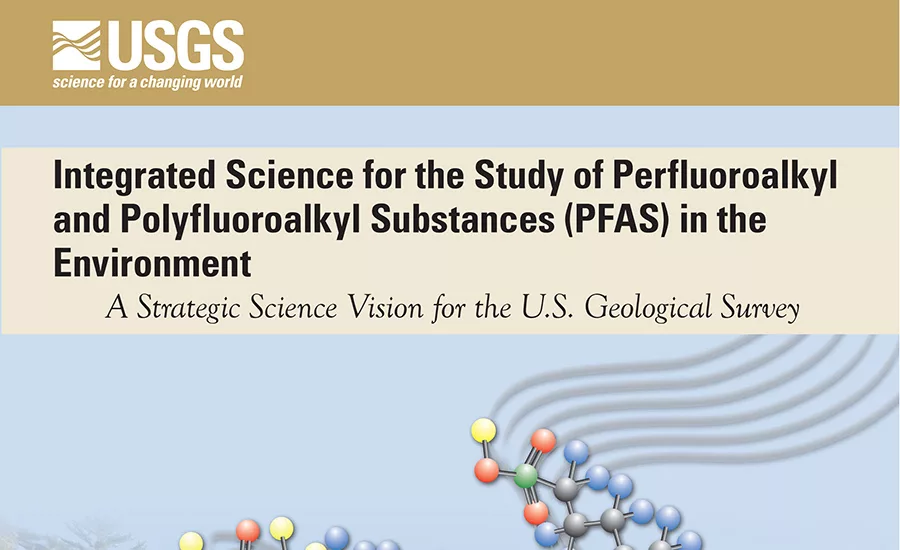Environmental Health
PFAS dangers: The saga continues
While FDA, EPA and NIH have been studying PFAS in water and food, the U.S. Geological Survey suggests there’s much more work to be done

In the September issue of FE, the Manufacturing News column looked at the ever-present, ever-dangerous chemicals in the PFAS family of compounds—actually numbering around 4,000 unique compounds altogether, each with a fluorinated chain, which makes the PFAS substance resistant to chemical and thermal breakdown. The most common forms of PFAS chemicals have been used in fire-fighting foams for petroleum fires (think aircraft) and in non-stick coatings of cookware.
While the FDA shared some good news that the elimination of these chemicals in food and beverages has been very successful, drinking water sources can contain these chemicals if wells or water bodies (streams, creeks, rivers, etc.) receive runoff from contaminated land. Since public water treatment works (POTWs) test for and filter these chemicals out of the water before it is distributed to customers, PFAS is not a problem. However, for private wells or untested water sources, that’s another story—because unless the water is tested, the owner will have no idea if remediation is needed
More work needs to be done
In spite of what we know about these chemicals, a recent study from the U.S. Geological Survey (USGS) suggests there’s a lot of work yet to be done on these potentially carcinogenic compounds in our environment. To make stakeholders aware of what it’s calling “PFAS science gaps,” USGS has released a strategy for dealing with these knowledge gaps.
The USGS strategy outlines the agency’s future scientific role in the study of perfluoroalkyl and polyfluoroalkyl substances, chemicals known as PFAS. This strategy identifies PFAS-related science opportunities that have informed ongoing USGS research and provides a strategic vision to address future science needs and opportunities with both existing and additional resources.
According to USGS, researchers have discovered accumulation of these PFAS “forever chemicals” in animal tissue, but the long-term health and ecological risks are not fully known. However, the NIH certainly suggests this family of chemicals is a “possible human carcinogen based in part on limited epidemiologic evidence of associations with cancers of the kidney and testis in heavily exposed subjects.”
A strategy for more research
“The more we learn about PFAS in the environment, the more we find how far we have to go to fully understand their persistence, their health and ecological impacts and their mitigation,” says Dave Applegate, associate director for natural hazards exercising the authority of the director, USGS. “The breadth and depth of its scientific expertise make the USGS ideally positioned to address these big questions and fill the science gaps to increase our understanding of PFAS movement, occurrence and distribution, notwithstanding the disproportionate impact on rural and inner-city communities.”
The new USGS PFAS Strategy identifies scientific gaps in ongoing analysis conducted by multiple federal agencies. The USGS is uniquely staffed and equipped to provide capabilities in the science of PFAS occurrence, distribution and effects. The USGS has a deep history in environmental science and monitoring of water, soils, and biota that enable it to effectively analyze how PFAS move through the environment, the potential hazards to wildlife, as well as public exposures in public and private well-sourced tap water. The strategy will provide stakeholders with the tools and information on environmental PFAS needed to identify environmental distribution, support regulatory decisions, and mitigate or prevent PFAS-related hazards.
To learn more about the 60-pp USGS study, “Integrated Science for the Study of Perfluoroalkyl and Polyfluoroalkyl Substances (PFAS) in the Environment,” or to download it, visit https://pubs.er.usgs.gov/publication/cir1490
A personal salute to USGS
As a side note, I can personally attest to the thoroughness of the USGS as it tested the air quality in my home as a result of a superfund site six blocks away, which had dumped degreasing chemicals such as trichloroethylene on the ground and into the nearby creek, which flows in our direction. As the company has been absent from the site for more than a decade, the USGS in conjunction with the EPA has been testing all homes, businesses and restaurants in the area for toxic fumes as well as replacing all the soil in and around the building. Thankfully, after leaving sampling canisters in our home for about a week, USGS found no problems with toxic fumes.
Looking for a reprint of this article?
From high-res PDFs to custom plaques, order your copy today!





